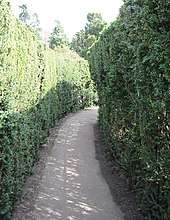Hedge maze
A hedge maze is an outdoor garden maze or labyrinth in which the "walls" or dividers between passages are made of vertical hedges.

History

Hedge mazes evolved from the knot gardens of Renaissance Europe, and were first constructed during the mid-16th century.[1] These early mazes were constructed from evergreen herbs, but, over time, dwarf box became a more popular option due to its robustness. Italian architects had been sketching conceptual garden labyrinths as early as 1460, and hundreds of mazes were constructed in Europe between the 16th and 18th centuries.[2]
Initially, the hedge maze was not intended to confuse, but to provide a unicursal walking path. Puzzle-like hedge mazes featuring dead ends and tall hedges arrived in England during the reign of King William III of England. It was possible to get lost in the much-admired labyrinth of Versailles, built for Louis XIV of France in 1677 and destroyed in 1778. This maze was adorned with thirty-nine hydraulic sculpture groups depicting Aesop's fables. The oldest surviving puzzle hedge maze, at Hampton Court Palace in Surrey, England, was built for King William in the late 17th century. Its distinctive trapezoidal shape is due to pre-existing paths running alongside the maze.
In modern times, hedge mazes have increased in complexity. A hedge maze at Longleat House in Wiltshire, England, designed in 1978, features a three-dimensional maze that uses bridges and a grid-less layout to confuse visitors.
Notable public hedge mazes

- Blackpool Pleasure Beach, England, has a maze, though only part is constructed from hedges.
- Blackgang Chine, Isle of Wight, England.
- Blenheim Palace, England
- Castlewellan, Northern Ireland, world's largest permanent hedge maze
- Chatsworth House, England
- Disneyland Paris has a hedgemaze in Alice's Curious Labyrinth, an Alice in Wonderland themed area.
- Egeskov Castle, Denmark
- The Garden Maze at Luray Caverns, Luray, VA, USA
- The Governor's Palace Maze in Colonial Williamsburg, Williamsburg, VA, USA
- Hampton Court Maze, England
- Kaeser Memorial Maze, Missouri Botanical Garden, St. Louis, Missouri, USA
- Laberint d'Horta, Barcelona, Catalonia, Spain
- Leeds Castle, England
- Longleat, England
- Bridge End Gardens, Saffron Walden, Essex, England
- Schönbrunn Palace, Austria
- Traquair House, Peeblesshire, Scotland
- Villa Vizcaya, Miami, FL, USA
See also
References
- Fisher, Adrian (2004). Mazes & Follies. Jarrold Publishing.
- Wright, Craig M. (2001). The maze and the warrior: symbols in architecture, theology and music. The President and Fellows of Harvard College.
Further reading
- MacQueen, Gailand (2005). The Spirituality Of Mazes And Labyrinths. Wood Lake Publishing Inc. ISBN 1896836690. Retrieved October 8, 2012.
External links
